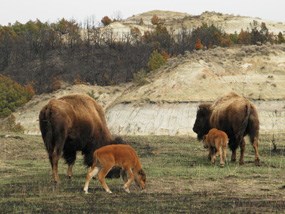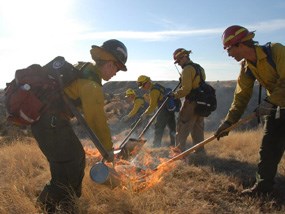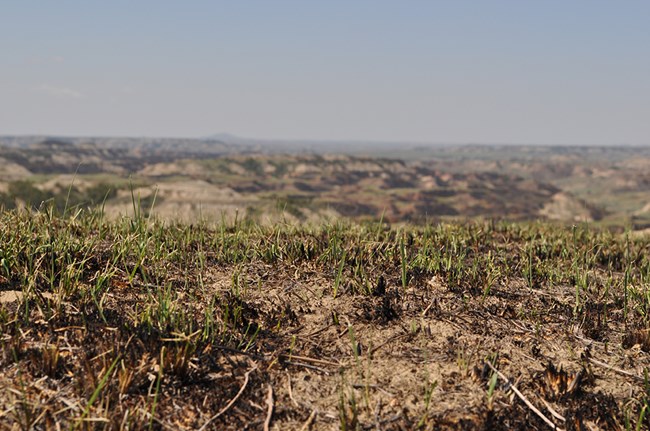|
When you think of the term wildfire, what comes to mind? 
NPS Photo Do you imagine a destructive fire burning everything in its path? Do you think of a natural process that is important to the health of the ecosystem? Do you picture the days and weeks after the fire as fresh, green growth sprouts from the ashes? Fire is a natural process that can be dangerous and beneficial depending on the circumstances. Theodore Roosevelt National Park's Fire Management Plan helps to promote the positive aspects of fire while preparing for and reducing the impact of the negatives. History of Fire Management For most of the 1900s, wildfires were extinguished immediately. The assumption was that this protects lives, property, and natural areas. This changed following the unusually intense fire season of 1988. After decades without fire, fuels built up as woody plants grew and died. Wildfires in these fuel-rich areas burned with uncontrollable intensity. This brought the realization that wildfire management was very misdirected, and land-management agencies like the National Park Service began to rethink their policies. The National Park Service Organic Act of 1916 mandates that national parks are to conserve and manage resources in a manner that will leave them "unimpaired for future generations." In that regard, fire is an important natural tool to promote ecosystem health. Further, National Park Service policy requires parks with burnable vegetation have a Fire Management Plan. Other fire policies and procedures are defined by the National Interagency Fire Center. Theodore Roosevelt National Park's Fire Management Plan allows not only for fire preparedness and prevention, but for the use of fire as a natural and man-implemented tool. Wildfire in Theodore Roosevelt National Park Like many forests, the North American prairie is a fire-dependent ecosystem. Fire plays a role in removing plant material and promoting new growth, essential to maintain habitat diversity. In the grasslands of Theodore Roosevelt National Park, the absence of fire allows woody plants such as sagebrush and junipers to become established, displacing the grasses and forbs that many animals require to survive. Wildfires occur in Theodore Roosevelt National Park on average once or twice per year. Variables contributing to wildfires include weather, lightning, and human activity. Lightning is the most common cause of wildfires. The Badlands terrain and sparse vegetation cause many wildfires to extinguish themselves. Other naturally-caused wildfires may be declared as wildland fire use. We allow these to burn to achieve natural resources management goals. Fires are extinguished by firefighters if they are started by humans, threaten human lives or property, or cannot otherwise be declared as wildland fire use. Fire is essential for grasslands diversity. This diversity changes over time in a process known as succession. Early successional plants include forbs and grasses, which later give way to shrubs, woody plants and trees. A natural grassland has a mosaic of areas in different stages of succession. Returning fire to the landscape in a responsible way allows Theodore Roosevelt National Park to sustain a mixed-age grassland, increase forage and habitat diversity for wildlife, and reduce the impact and intensity of wildfires. These fires are known as prescribed burns. 
NPS Photo Prescribed Fire Theodore Roosevelt National Park's prescribed fire program addresses three interrelated goals. A prescribed fire can address one or more of these goals simultaneously. To maximize benefit and reduce risk, a burn is performed at a precise time of year and under favorable weather conditions.

Fire Management Plan The Fire Management Plan of Theodore Roosevelt National Park maintains the processes and benefits of natural wildfires. Prescribed fires help combat invasive plants, control prairie succession, and benefit wildlife grazing. The park utilizes vegetation data to monitor how these fires affect plant species years after a burn. This data is crucial for future fire management decisions. The Fire Management Plan addresses both the positive and negative aspects of wildfire. The program's successes help maintain ecosystems that reflect the natural landscape, and protect human lives and property from uncontrolled wildfires. |
Last updated: October 7, 2021
